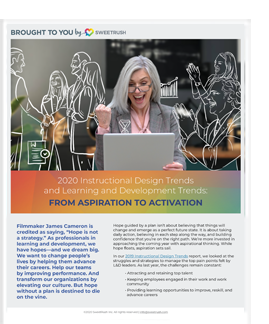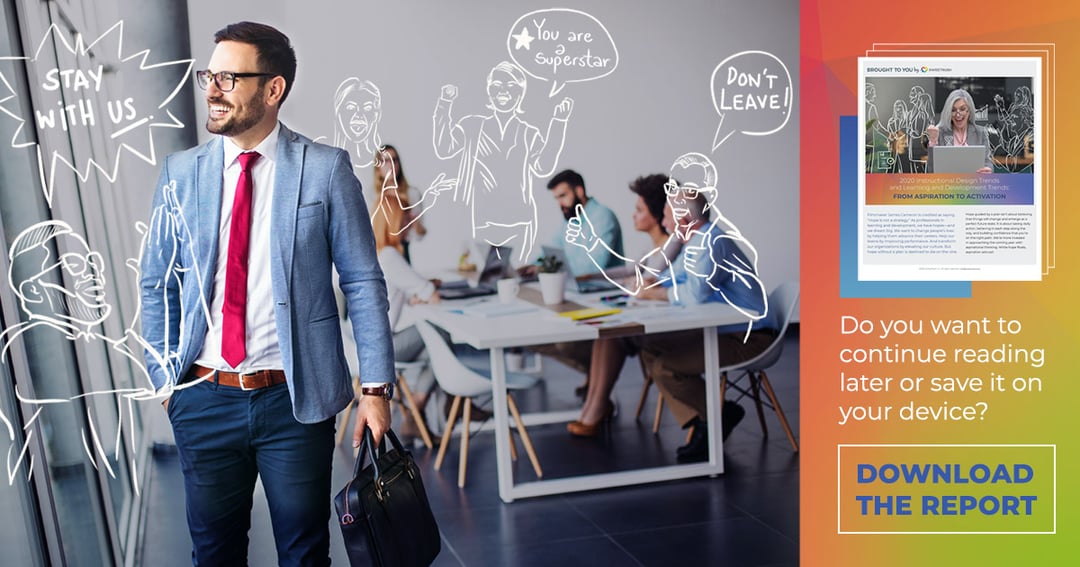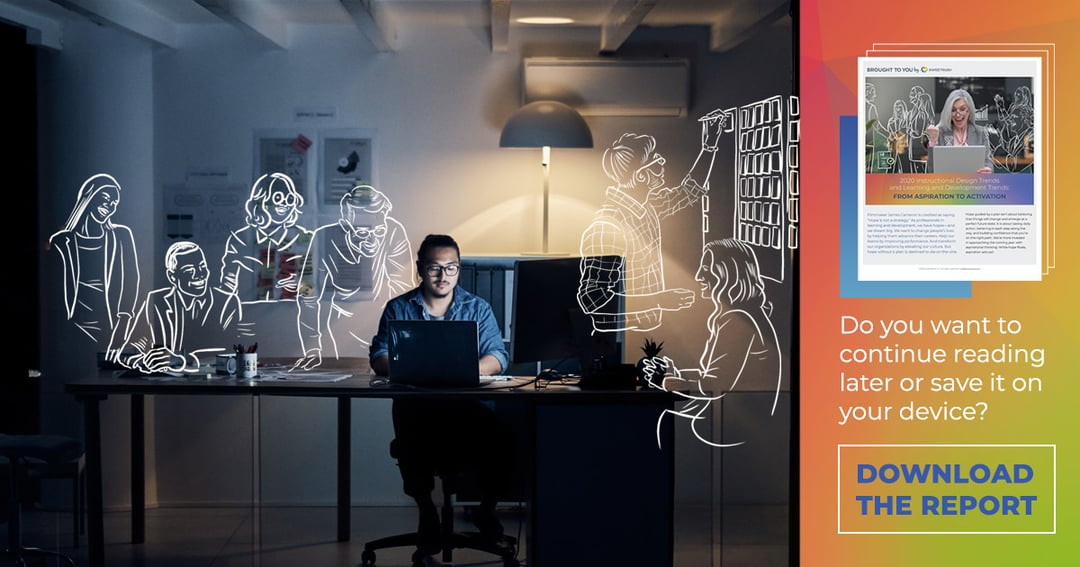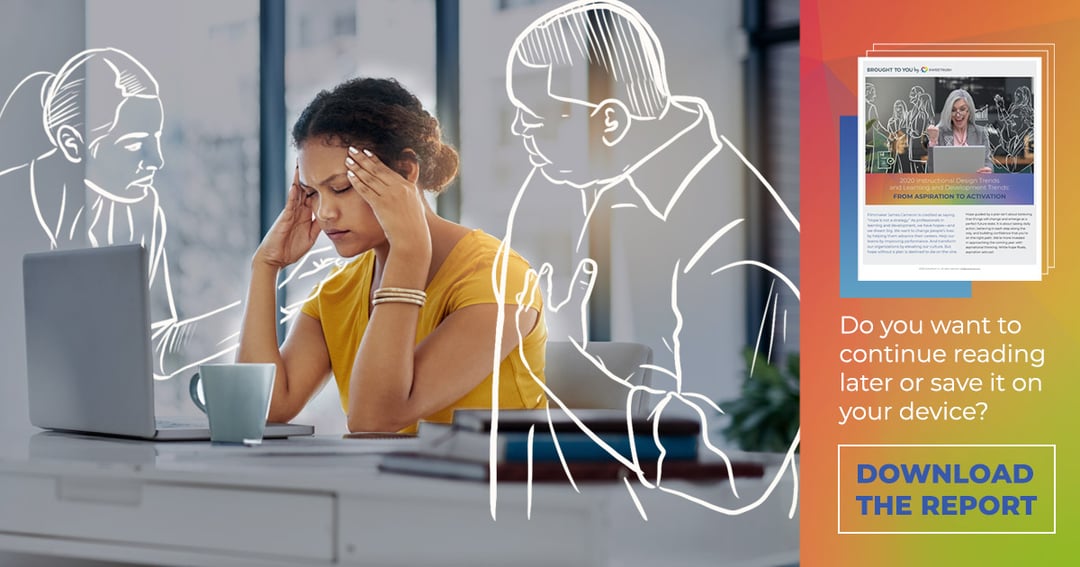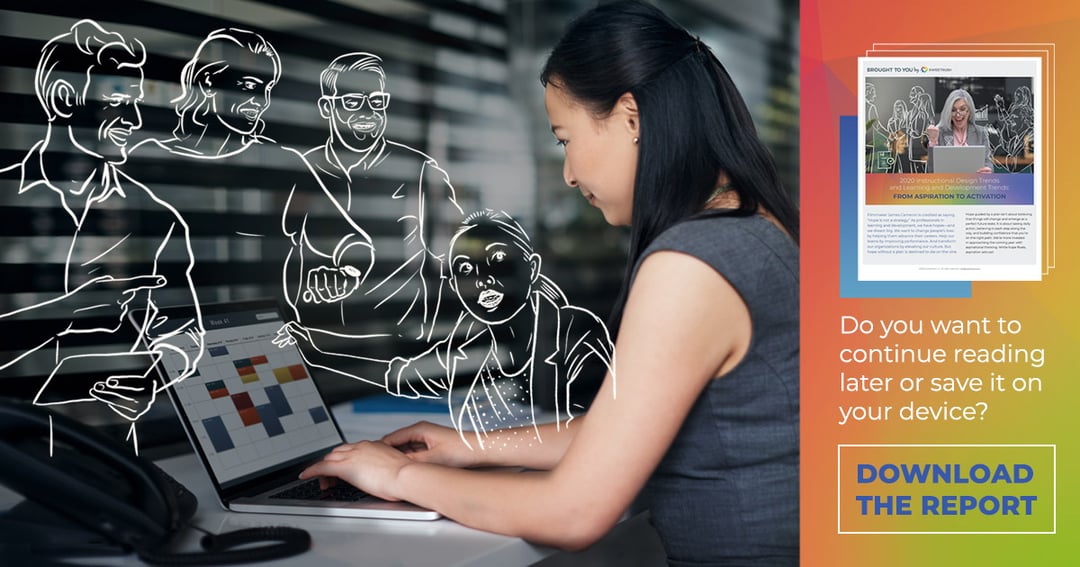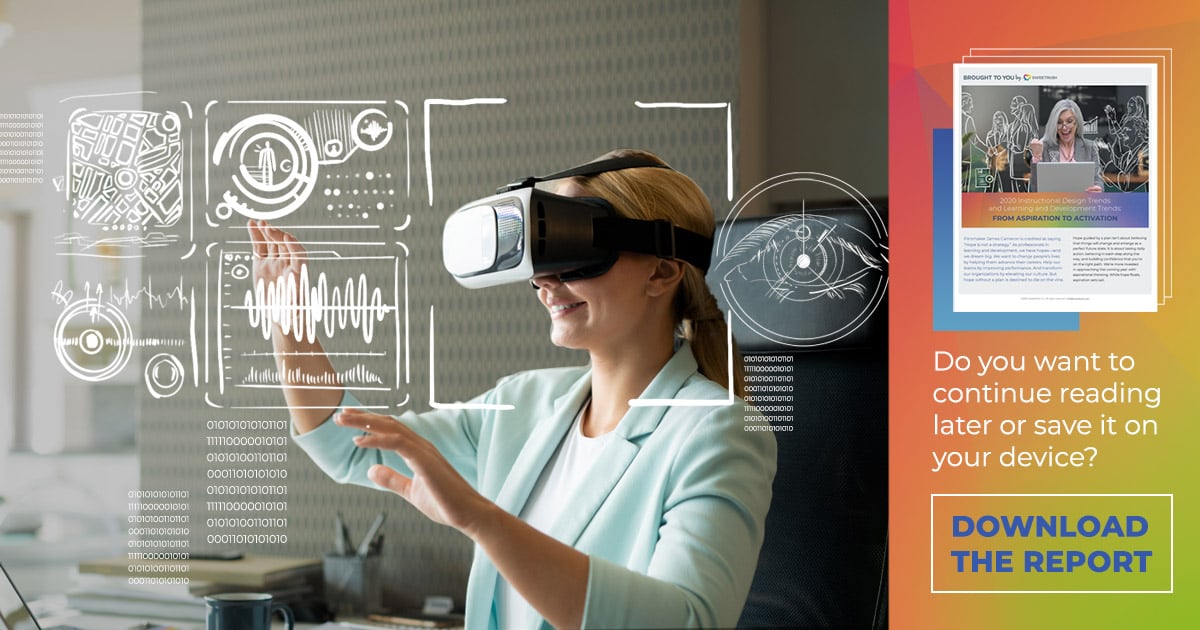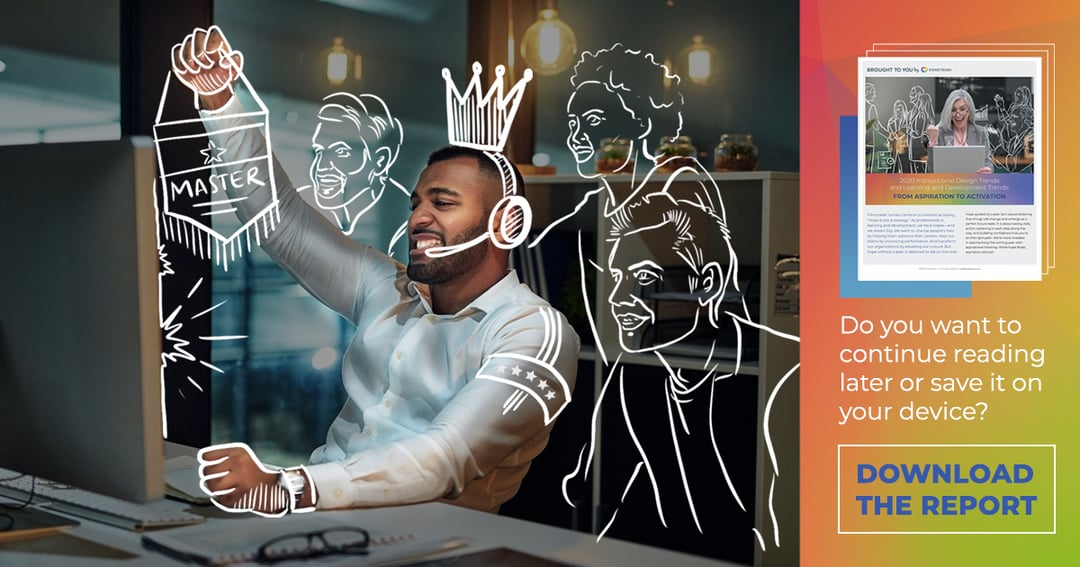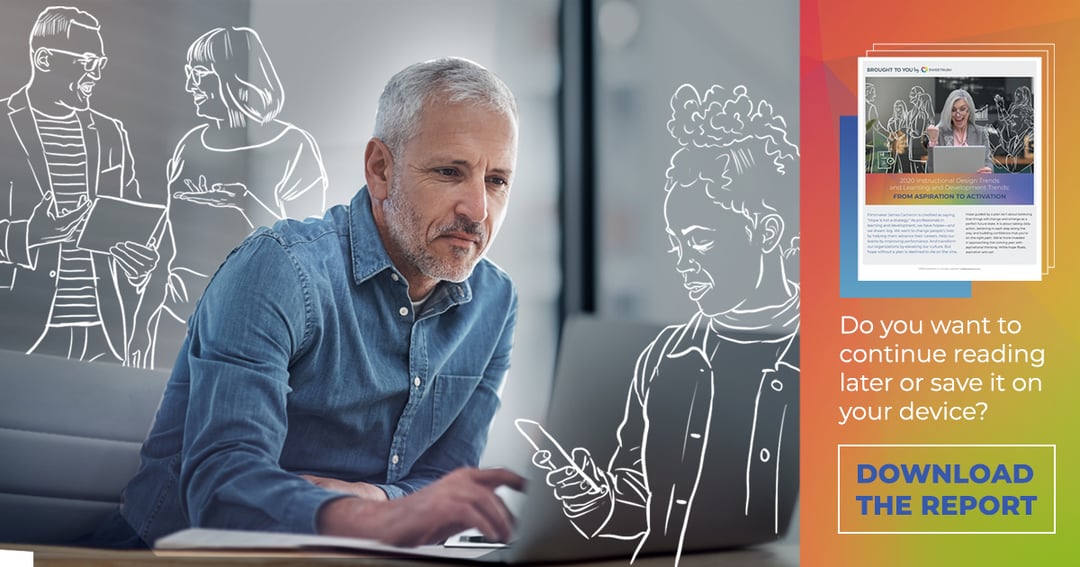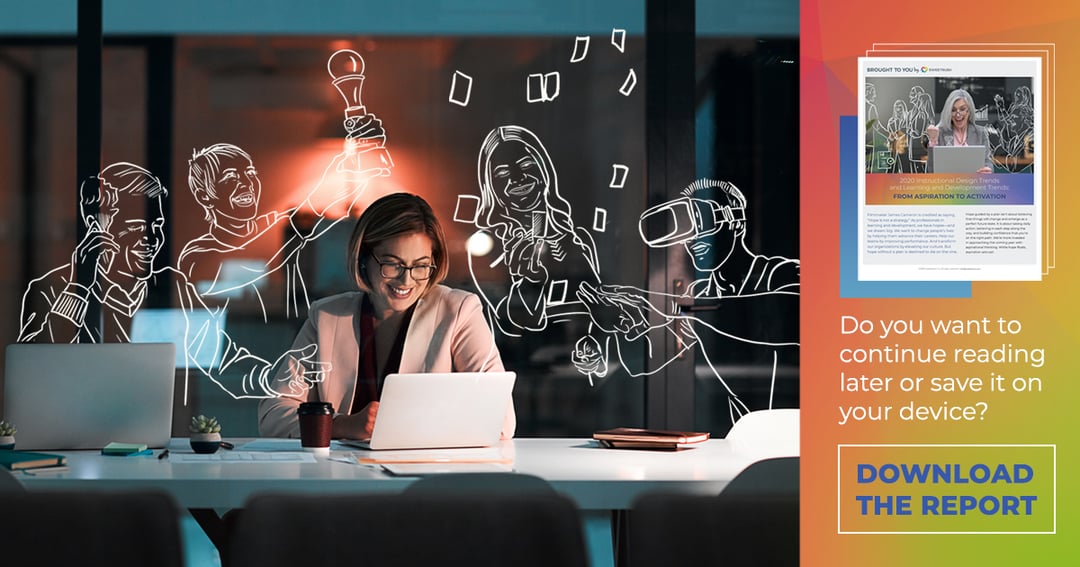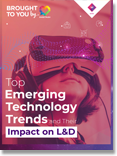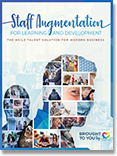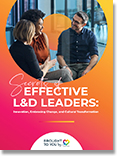Filmmaker James Cameron is credited as saying, “Hope is not a strategy.” As professionals in learning and development, we have hopes—and we dream big. We want to change people’s lives by helping them advance their careers. Help our teams by improving performance. And transform our organizations by elevating our culture. But hope without a plan is destined to die on the vine.
Hope guided by a plan isn’t about believing that things will change and emerge as a perfect future state. It is about taking daily action, believing in each step along the way, and building confidence that you’re on the right path. We’re more invested in approaching the coming year with aspirational thinking. While hope floats, aspiration sets sail.
In our 2019 Instructional Design Trends report, we looked at the struggles and strategies to manage the top pain points felt by L&D leaders. As last year, the challenges remain constant:
- Attracting and retaining top talent
- Keeping employees engaged in their work and work community
- Providing learning opportunities to improve, reskill, and advance careers
This year, we’re excited about what aspirational L&D professionals are doing to move the needle. What are they currently doing to set sail? The response from our client-partners and the SweetRush team was amazing, as you’ll read. Their input was invaluable in helping us craft this report and gives us more than hope for the year ahead.
What does a thriving company culture and L&D team look like for your organization? What mental mindset do people need to adopt to succeed in a modern workplace? In this year’s report, we examine the activities and strategies that innovative organizations are embracing, and what mindsets are being left behind in the wake of cultural transformation and the evolution of L&D. Pretty lofty stuff, don’t you think? But what better time of year to consider the potential for growth and setting sail toward the true north of success?
There are so many solutions. Doing a quick search, you’ll uncover the mountain of practices, technologies, and methodologies. Perhaps the confusion you’re feeling is the same as your learners feel when bombarded by a mountain of learning content.
![]() What’s your moment of clarity in all this confusion?
What’s your moment of clarity in all this confusion?
What are you dreaming about? What challenges are you looking to solve? There are many products and solutions, but what is your culture like to begin with? What are your people like? What do they value? How can you put solutions together in a way that’s unique to you? That’s the real task for all of us L&D professionals in 2020.


1. The Tightening Link Between Culture and Learning
2. Organizational Culture Change: Shifting Mental Models and Adopting a Growth Mindset
3. Building Leadership Competencies and Soft Skills Across All Roles
4. L&D Under Pressure: Rapid Development
5. Staff Augmentation Trends: The Rise of the Learning Consultant
6. The Impact of Emerging Technology on Learning—Exploring Beyond the Buzzwords
7. Looking Beyond Gamification Toward Gaming and Simulation Experiences
8. Farewell One-Size-Fits-All: Human-Centered and Adaptive Learning
9. Reduce Demand on Learners’ Time
1. The Tightening Link Between Culture and Learning
Traditional theories about hiring and retaining top employees no longer fit into the post-millennial world. Record low unemployment rates dominate the market. The gig economy encourages workers to maintain autonomy over their lives and career paths. Employees expect greater transparency, accountability, and value (think total compensation) from their employers. And employers need to understand the value they can provide potential hires.
Research shows two significant drivers for attracting and retaining employees are company culture and the availability of learning and growth opportunities.1 Modern employees are constantly on the lookout for new opportunities, new skills, and new positions to improve their careers and their personal lives. And they’re looking for meaning and purpose in their work.
Your employees are asking, “What’s in it for me?” Are you listening? Sixty percent of Gen Zers claim to have managerial positions as a career aspiration. In fact, 76% expect a promotion after only a year of employment. And an astonishing 55% are invested in the idea of starting their own business. As this Medium article suggests, consideration should be taken to better understand employees’ career development aspirations to groom potential managers.5 The modern employee is creative, aspirational, and entrepreneurial, and they’re looking for a company to help them build the skills they need to elevate their careers.

But the burden of fulfilling the hopes and dreams of the modern employee doesn’t fall on the shoulders of one team alone. Successful organizations understand that this isn’t just an HR problem. It’s not an L&D problem. It’s an issue that requires buy-in from every team in an organization; from the top, and at every level.
As Alexandra Jabs, Solution Architect at SweetRush, explains, “There is an inherent link between L&D and a company’s culture. Successful companies understand the value of investing in people.”
We’re seeing an increased emphasis on culture among our L&D client-partners, focusing on driving aspirational thinking toward the activities, plans, and strategies that will ultimately transform L&D teams and their organizations as a whole.
Ashley Munday, Director of Cultural and Organizational Transformation at SweetRush, says, “More and more SweetRush L&D clients have been approaching us for culture guidance and support. It has ranged from holistic organizational change management to team development workshops. There's a new era in learning and development: You are engaging the whole person. This involves new technologies and mental model shifts. I think this is both exciting and daunting for our clients, and we're thrilled that we can help them transition more smoothly.”
Savvy employers are seeing learning and development as a competitive advantage and as a form of compensation to attract new talent. At the same time, they’re understanding that (though it may seem counterintuitive) enhancing their employees’ skills has benefits that outweigh the risk that employees will take their skill set with them to another company.
Truly innovative organizations are using every training moment as an opportunity to engage with employees on a more meaningful level. For example, if you have a captive audience of learners taking compliance training, this can be an opportunity to market learning material for career development resources. This isn’t the time for a “one-size-fits-all” approach, but a time to focus on human-centered practices (be they adaptive learning strategies for L&D, agile development team realignment, or company-wide strategies).
![]()
We predict that 2020 is the year for companies to design and develop higher quality, learner-centric programs that support cultural transformation and embrace values-based messaging. They have the chance to delight and surprise new hires from recruiting, through onboarding, and continually along an employee’s career path. Now is the time to invest in culture and L&D like never before.
“A good culture creates the gravitational force that keeps employees from spinning off, not unlike the force that holds a marriage together,” explains Arturo Schwartzberg, SweetRush Co-founder, CFO, and Board Chairman. “Treat people honestly and well, foster an environment of growth, and care about people and the planet—and act accordingly. It's really not a secret formula.”
-------
1. https://www2.deloitte.com/ro/en/pages/human-capital/articles/2019-deloitte-global-human-capital-trends.html
2. https://resources.insideoutdev.com/ebooks/gen-z
3. Ibid.
4. Ibid.
5. https://medium.com/coaching-notes/maker-mind-vs-manager-mind-f4e01d294d34
2. Organizational Culture Change: Shifting Mental Models and Adopting a Growth Mindset
You may not know the cause of a problematic culture, but you can definitely feel it when it’s there: disorganization, siloed teams, politics, and miscommunication. Shifting from this type of culture to one that breaks down walls and energizes everyone to do the best work of their careers, isn’t just nice to have. It’s essential for an organization’s future.
Embracing change is a holistic undertaking, not simply a series of tasks bolstered by flowery language. It’s a shifting of mindset and of mental models. Successful organizations are willing to jump in with the belief that their activities will genuinely lead to the desired results.
![]() Read the article 3 Elements of a Powerful Vision for Organizational Change for more on taking these first steps.
Read the article 3 Elements of a Powerful Vision for Organizational Change for more on taking these first steps.
Discussing cultural problems at the leadership level can be difficult. Determining the steps to change can be a challenge to communicate. When people’s jobs are at stake, emotions live within every decision an organization makes. Some will be happy. Some not so much. But having only the hope that things will change is not building a strategy for the work ahead. If you want to have high-functioning teams, bolstered by trust, the ability to give and receive constructive feedback, strong communication and collaboration skills, you need to build competencies around it.
Changing mental models requires patience, practice, and of course, learning. Organizations don't institute this level of change by sending out a memo, or through a 45-minute PowerPoint presentation. They must lead by example; they must live it, practice it, and reinforce it at every opportunity. Change management, organizational culture change, and cultural transformation are framing a holistic approach to how a company demonstrates and measures its value and goals.
![]() For more insight, check out this infographic on change management and the steps to building trust.
For more insight, check out this infographic on change management and the steps to building trust.
As Christopher Pappas, Founder of eLearning Industry describes, “It's more evident than ever that organizations need to invest in cultural transformation, no matter their industry. Shifting your leadership mindset should be your number one focus. This is precisely the mindset of successful L&D leaders. Such a mindset is also what makes businesses stand out.”
For deeper insight, check out Secrets of Effective L&D Leaders for practical advice and tools for implementing change responsibly.
And it’s not just dysfunction driving the need for organizational culture change: The rapid pace of business and the rise of automation are creating significant pressure on organizations to adapt. We’re seeing organizations embrace a growth mindset and encourage employees to fail fast, learn fast, continue to learn, and adjust to new conditions. They understand the value of giving employees time to engage with learning experiences: practice, reflect, rinse, and repeat. This is a cultural shift that links directly to the success of learning and development programs.
Nurturing the creativity, innovation, and collaboration of their team members is key to business success. This brings with it the need for quick and personalized training methods to ensure the workforce is continuously learning, engaging with learning, and moving forward with the organization’s values and goals top of mind.
![]()
The growth mindset takes training to another level. There is a trend toward teaching employees how to work within the organization under new methodologies (such as agile). In 2020, we anticipate that training, recruiting, and onboarding of all employees will become more aligned to the overall cultural transformation strategies undertaken by organizations.
We’re already seeing organizations take new approaches to training, which would in the past have been focused primarily on process and procedure. To improve employee engagement with learning, organizations are now embracing behavior change, awareness, and reflection. There is enormous value in training employees to be better at listening, sharing ideas (earlier rather than later), and collaborating (rather than holding and presenting).
Good instructional designers have always sought to uncover and communicate the WIIFM (“what’s in it for me”) behind learning for their audiences. Today, employees from all levels of an organization need to understand the larger “why” of their organization’s mission. They need to understand:
- Why is the work we do important?
- How does our work contribute to the organization’s success?
- Why is it essential that the company move in this direction?
- What can each member of the organization do to support that move?
Finding opportunities to integrate these questions within learning materials, coaching, and development is a strategy that brings the aspirational to activation.
3. Building Leadership Competencies and Soft Skills Across All Roles
As companies see cultural transformation as a business strategy needed for growth and success, employees and teams that can demonstrate innovation, collaboration, resilience, growth mindset, and learning agility are highly desired. They’re also poised to be the organization’s next generation of leaders and executives.
This puts leadership training into focus. Leaders are charged with driving cultural transformation, while also espousing the principles and values of that transformation. Soft skills such as empathy, giving and receiving feedback, and having difficult conversations are the necessary skills required to enact and support this change over the long term.
Progressive organizations are seeing that these competencies are needed at all levels of the organization. Whether it’s a manager of a small development team, or the team members themselves, anyone can be tasked with the challenge of mentoring and educating (manager to employee, or peer to peer). L&D can take charge by leading the charge and by providing customized learning programs that speak personally to the vastly different personas under its purview: managers and leaders, employees and contractors. Each has different learning requirements and different learning styles. In our opinion, instructional designers need to provide personalized learning paths with language and competencies specific to each learner.
Clare Dygert, Director of Instructional Design, says “Organizations are moving away from hiring a specific degree toward hiring for competencies. Partners like SweetRush help identify those competencies and strategize around what those certifications and learning paths might look like.”
Additionally, these skills can’t be taught in a one-off course: context, application and practice, reinforcement and performance support must all be included in the holistic learning experience, regardless of how it’s delivered. Learning must be continuously delivered, regardless of the mode (microlearning, PDFs, digital learning), or focus can be lost.
Training Industry’s 2019 report claims (and rightfully so) that, “Soft skills are not learned in a one-and-done training event. To truly develop these skills, employees require multiple training experiences over an extended period of time to learn and practice them.”
![]()
eLearning has the capacity and ability to scale to provide soft skills training to a large audience of learners more effectively and more efficiently. Storytelling is at the heart of this success.
Kristi Hodges, Director of Talent Development at the American Medical Association, tells us, “We use eLearning to communicate a variety of complex topics like medical ethics, identifying suicide risk, collaboration skills, resiliency. We’ve found that a key to communicating information that is not cut and dried is embedding familiar, relevant scenarios so the audience can link the content back to their real-world experience. Telling a relatable story is a quick way to create an emotional connection with your audience. The AMA’s goal is to create that connection in the first minute of learning, because physicians are incredibly time-pressed.”
Another key trend is the need to practice. You can’t ask learners to think creatively, give them a 10-question quiz, and then abandon them. Learners need the chance to demonstrate their skills. They need the time and the means to reflect upon the learning and have a safe space to practice what they’ve learned. Quality and realism matter, as do UI and UX: meaningful and polished graphics, logical mechanics, and clear instructions.
Kristi continues by explaining, “The AMA Ed Hub’s™ ultimate goal is to improve clinical outcomes. eLearning is convenient, allows our busy audience to quickly consume information and avoid cognitive overload, is cost effective, and incorporates various methods that speak to different learning preferences (video, animation, case vignettes, simulated interactions, etc.) to visualize how content could apply in one’s daily practice. We recognize that one-off educational interventions are not easy to scale, and eLearning allows us to combine quality and volume in an effective way.”
-------
6. https://trainingindustry.com/magazine/nov-dec-2019/trends-2020-the-broadening-role-of-ld/
4. L&D Under Pressure: Rapid Development
Speed is the number one trend in developing and delivering L&D programs. For L&D professionals, managing change to meet a company’s evolving needs, while continuously improving and providing rapid delivery, is a tall order. L&D is in a precarious position. It may not have adequate resources, nor effective tools to deliver on project timelines.
While a waterfall methodology might have worked well in learning design in the past, the need for rapid development is changing the way we create learning. Erin Krebs, Director of Client Solutions at SweetRush, describes this evolution, saying, “L&D leaders are getting smarter about learning design. They’re asking how to marry the traditional waterfall design to agile. They’re looking to develop a process for an agile ADDIE (Analyze, Design, Develop, Implement, and Evaluate) model.”
The seeds of process change took root in 2019 as L&D teams began to experiment with—and find success in—applying design thinking to learning solutions. We’ve embraced design thinking to address risks and flaws in established learning design methodologies, creating a collaborative experience we call “CoDesign.” CoDesign allows us to better serve our client-partners’ needs by building empathy and creating alignment among designers, stakeholders, and learners—and enabling better, more learner-centric solutions in a faster time frame. In essence, we front-load the design process to ensure that there are fewer surprises down the road.
And, significantly, a two-day working session can shave weeks off an asynchronous solution design process.
Clare Dygert explains, “The use of design thinking, especially in prototyping, is helping our clients with the challenge of identifying and speaking directly to their audiences. Who is the learner? What are the requirements? We’ve discovered that CoDesign has been enormously successful.” Rapid prototyping and testing in the design thinking process help designers and stakeholders come to a decision about the solution more quickly.
For more, check out what Clare has to say about the five-step process of design thinking and how to design new hire onboarding.
In addition to reducing the project timeline and gaining faster alignment on the solution design, CoDesign provides an immersive, intensive, collaborative experience, which deeply bonds the team. SweetRush Solution Architect Annie Hodson shares this observation: “I’ve seen a huge reduction in escalations for projects that begin with CoDesign. In the past, it’s been challenging to align all stakeholders and adapt the solution as more information becomes available. The CoDesign experience significantly mitigates those risks.” These risks can often translate to project delays and elongated timelines as teams work to get back on track.
Responding rapidly to business needs for learning interventions often means simply getting experienced, qualified L&D professionals in the door and ready to hit the ground running. But simple doesn’t mean easy: According to SHRM, the average time to fill a position is 42 days!7 Not exactly a rapid development strategy. So L&D leaders are turning to specialists—staff augmentation partners focusing on learning and development—to augment their teams and bring on specific skill sets.
Rodrigo Salazar, Manager of Talent Solutions at SweetRush, says, “We always hear ‘We’re stressed, we’ve been looking for this role for six months, using our internal recruiting team. Everyone seems to have a job.’ When we do this in three weeks, it seems like magic.”
-------
7. https://resources.workable.com/tutorial/faq-time-to-fill-hire
5. Staff Augmentation Trends: The Rise of the Learning Consultant
To support agile talent and rapid delivery trends, we’ve seen an increase in demand for staff augmentation to address skill gaps in L&D teams. The main pain points for recruitment remain as ever. To:
- Find better talent.
- Reduce costs.
- Do it all faster.
Not only can staff augmentation help L&D produce faster time-to-market results by simply having more hands on deck, it also reduces the cost of finding and training L&D talent. For example, there is less burden on HR and reduced cost for onboarding or when an employee leaves a position. And for L&D leaders facing a hiring freeze or limit on their budget for FTEs, temporary talent can be a workaround that addresses their resource needs.
![]()
But here’s the trend: Rather than going to traditional staffing vendors with a limited L&D talent pool, there is greater interest in working with more robust learning partners. Why? Because of the added value of connecting with a community of learning experts.
Ann Cathers, Talent Solutions Consultant at SweetRush, explains, “We’re seeing a shift away from the transactional relationship between recruiter and candidate. There is value in a trusted resource arrangement.”
Staffing vendors that create desirable, trusted relationships with candidates are then able to establish a robust pool of experienced learning professionals ready and able to take on challenges for L&D leaders.
Annette Caneda, Instructional Designer and Learning Consultant at the University of California, San Francisco, explains that, “A true learning partnership isn’t just for filling a spot, a one-size-fits-all solution. Organizations can be myopic. They can get stuck in a rut. A partner with experience with other L&D teams and organizations can bring awareness to the common challenges and trends that other organizations face. A learning consultant is better equipped to bring a fresh, broad perspective, and to look at the larger context. They can boost you up!”
Not only does this type of consulting partnership highlight the trend toward agile talent, but it also supports the career success of L&D professionals. To fulfill projects and add specialized skills to their teams, L&D leaders are turning to learning partners and staff augmentation vendors that focus on L&D talent for support.
6. The Impact of Emerging Technology on Learning—Exploring Beyond the Buzzwords
It would be impossible to not mention the ongoing interest in emerging technologies such as VR, AR, AI chatbots, virtual assistants, and so forth. But technology is only as effective as the learning path behind it. And is it affordable and scalable?
![]() Our well-attended 2019 webinar gives advice and insight from our client-partners around using VR for learning—so check it out!
Our well-attended 2019 webinar gives advice and insight from our client-partners around using VR for learning—so check it out!
The past two years of research and practical application have shown us that VR is a great tool for teaching soft skills, empathy, and safety. VR learning simulations enable participants to walk in the shoes of others and practice using new skills in a safe environment, while giving instructors the data and ability to monitor all events for assessment.
“Tech in education means you can reach a wider audience in terms of age and digital literacy,” explains Adrian Soto, SPARK Team Manager at SweetRush. “But this puts greater emphasis on design thinking and the role that UI/UX will play. Our role—and goal—is to make the graphics as stunning and real as possible.”
With advancements in hardware, we’re seeing a rise in the affordability and accessibility of untethered devices. These headsets are making scalability a reality for many companies. But as Adrian states, “It’s time to think outside the headset. The real trend is in data acquisition, and what can be done with that data.”
![]() Check out our infographic Emerging Technology Trends in Learning and Development to see the impact of learning technology.
Check out our infographic Emerging Technology Trends in Learning and Development to see the impact of learning technology.
In the near future, it’s going to be possible to monitor the biometrics of participants in a VR simulation. Eye movement, body posture, heart rate, and even brain waves may be monitored and used to provide even more realistic simulations of real life work. Trainers can get a holistic understanding of the way employees learn, engage with content, and interact with real people. It will be possible to interact with participants within a simulation. For example, an instructor observing a learner in a VR space can trigger events or surprises to see how he or she reacts.
![]()
In the future, we foresee a symbiotic relationship between learners, the technology, and the flow of data back and forth to support educators.
SweetRush recently created a VR learning experience to help our client-partner, a nonprofit hospital, teach employees how to de-escalate violence in hostile situations. The solution included placing the learner in a story and creating 3D visuals and realistic avatars specific to the hospital environment.
In another example, SweetRush was tasked with creating safety training specific to the learner’s actual workplace and work tasks. This proved to be immensely useful in helping workers learn and practice safety. Within a VR simulation, learners receive prompts about maintaining the correct posture, selecting the right tools for their job, and moving through the required steps in virtual space. Voice recognition is used to analyze and provide feedback on the tone of voice.
In the future, it will be possible to monitor on-the-job behavior (e.g., wearable devices, IoT sensors) to trigger point-of-need training—like microlearning resources. Thus, training is absorbed through repetition and practice. This, as Betsy Lee, Learning Architect at SweetRush says, is essential. “Spaced repetition is a vital aspect of learning science. One exposure isn’t enough. Employees need to engage in multiple exposures to the same content to ensure retention.”
Augmented reality and mixed reality allow companies to take onboarding to a whole new level. Training can be done on the job and in real time by overlaying learning content onto real-world work environments. Employees can point their phone at a piece of equipment and have training material, manuals, instructional videos, or helpful tips pop up onto the screen.
We’re excited about the advancements that 2020 brings. And you should be too!
![]() For an in-depth look at the future of learning, read Top Emerging Technology Trends And Their Impact On L&D.
For an in-depth look at the future of learning, read Top Emerging Technology Trends And Their Impact On L&D.
7. Looking Beyond Gamification Toward Gaming and Simulation Experiences
Gaming and gamification continue to be on the radar for learning leaders. But they need to actually engage, wow, and connect to learning outcomes in a personal, unique way. Otherwise, they’re just another time-eating burden for the busy employee. Sure, you can assign points to learning material, you can award badges and put names on a leaderboard. But does it mean anything? Does it translate into successful learning?
![]() Read our article on gamification and employee engagement for a deeper dive into how the two are connected.
Read our article on gamification and employee engagement for a deeper dive into how the two are connected.
We’re seeing a movement from generic gamification elements to more immersive digital gaming and simulation experiences. The L&D industry is embracing a combination of instructional design and game design, with more emphasis on game mechanics than ever before. The increasing availability of mobile devices in the workplace offers new technology options outside the desktops, be they browser-based or native app. And VR is taking the immersive experience to a whole new level.
Smartphones came with a learning curve (touch to click and drag, pinch to zoom, etc.). Now the interface and gestures have become second nature to users. In the same way, gaming is becoming more accessible, affordable, and scalable: Oculus Quest devices sold out over the holiday last December!8
First, ask yourself: Is a game the best way to distribute particular content? The question that is always top of mind for instructional designers is “What is the best method and mode for teaching the core material?”
You need to provide creative and engaging learning experiences, and games can be a great option to do so. But you must avoid the cardinal sin of wasting your learners’ time. As such, it’s important to explain the value of playing the game, its learning outcome, and respond to the question: “What’s in it for me?” While technology-enabled learning games are on the rise, sometimes an effective learning experience is “inside the box”: e.g., a board game.
Sherri Schachter, Production Manager at Google Cloud Learning, explains that “Gaming seems cool and people are talking about it. But even though some applications are clever, they’re not impacting the learning experience. We’ve seen great success in taking a creative approach to in-person gaming. For us, there was enormous value in presenting a game in a physical space. Role playing enabled players to develop empathy for positions other than their own. Communication and collaboration were fundamental to gameplay. The tactileness was also part of its success. Our team engaged all of their senses.”
Whether a board game, or an immersive 3D game, the result should always be the same. Instructional designers must ensure that no matter the format, games must tie directly to learning outcomes and meet business requirements.
![]()
We anticipate this trend to grow in 2020 as organizations work with top gamification companies to customize the technology to suit their employees’ gaming skills and effectively reach multi-generational audiences. We’ve seen how gaming can be used to train hard skills, but it can also develop empathy and creative thinking, along with providing networking benefits and collaboration skills.
-------
8. https://www.fool.com/investing/2019/12/27/oculus-devices-sold-out-in-positive-sign-for-virtu.aspx
8. Farewell One-Size-Fits-All: Human-Centered and Adaptive Learning
Adaptive learning has been a “trend” in articles for years—at least in an abstract way. We’ve seen concrete movement toward design thinking, or human-centered design. Innovative L&D professionals are evolving beyond the inefficiency (for the learner) and expense (of wasted time in unneeded training) of the one-size-fits-all model. L&D is discovering ways to provide a learning experience tailored to the unique understanding, skills, and interests of each individual learner.
Consider the varying attitudes of a multi-generational workforce. Each employee may have a different relationship to training and technology. Career development may differ between generations. Consider also the need to provide accessible and unique learning experiences on a global scale.
L&D professionals have struggled to bring adaptive learning into the business conversation: to advocate for change. Can adaptive learning be done in a cost effective and efficient way? Can the learning design give learners more freedom, while also ensuring core learning material is absorbed and assessed? Does it take more work to design? Does your organization have the resources and expertise to do it?
We’ve seen resistance continue to fall away in 2019 and witnessed innovative approaches that are making adaptive learning theory work in execution. For example, learning material and learning paths can be differentiated based on knowing each learner’s role using an early questionnaire, or perhaps derived from data collected through a learning management system (LMS). Pre-assessments, or “testing out,” enable learners to progress more efficiently through training by skipping material they’ve already mastered. Well-crafted “detours” allow learners to explore additional content they need or have an interest in knowing. This gives learners a greater sense of autonomy and control over the speed of their learning journey and less of a feeling like they’re being forced to absorb material that is irrelevant.
The technology to support human-centered learning is becoming more affordable. Chatbots provide a user-friendly (and delightful) interface to enable learners to search for (and actually find!) relevant learning material. Again, with a few clicks, learners can sift and disseminate a ton of content to get answers quickly. We’ve seen chatbots being used to manage the challenges of legacy LMSs, since they can easily overlay existing technology and provide an artificial intelligence-like interface for easy navigation. They require little in the way of IT support and implementation, which makes them affordable while also scalable across the entire organization.
The trend: Teach globally, design locally.
From what our clients are saying, multi-modality in adaptive learning is on the horizon for organizations in 2020. Aimee Lantzy, Solutions Architect at SweetRush, explains that “There’s no such thing as ‘I just want eLearning or ILT.’ Clients are becoming more savvy at mixing modes and formats.”
For some learning projects, it makes better sense to use instructor-led training as a means of implementing company-wide training. In other cases, custom eLearning, virtual instructor-led (vILT) training is the solution.
Rather than relying on eLearning or emerging technology as a simple fix (a catch-all, if you will) to successfully fulfill L&D projects, leaders are looking beyond the buzzwords to more comprehensive solutions to provide human-centered learning—yes, traditional ILT might be the best solution! In addition, employees are encouraged to embrace mentorship possibilities and peer-to-peer content delivery. When everyone is empowered to teach and learn, everyone participates in creating a culture of learning.
With a nod toward Marshall McLuhan, the medium (or learning mode) depends entirely on the message (adaptive learning outcome).
Our take is: First, make sure you understand your business challenge, objectives, and constraints, and your learners’ needs, environment, and desires. (Yes, we’re back to design thinking.) Then create a learning strategy with the best mix of modalities to achieve and address those things. If your team engages better with a customized board game that addresses the desired learning outcome, then perhaps that’s the best mode for that particular program. If VR and simulations through meaningful storytelling can deliver on the promise to provide training in soft skills, then technology is vital to success. But if VR games and AI are simply talking points around your board tables, consider the reason behind why these terms are being brought up. Take a customized—and human-centered—approach to delivering learning and development.
![]() Learn more in our essential guide: Hats Off to Adaptive Learning: Tailoring Corporate Training for Each Learner.
Learn more in our essential guide: Hats Off to Adaptive Learning: Tailoring Corporate Training for Each Learner.
9. Reduce Demand on Learners’ Time
Besides supporting continuous learning strategies, microlearning provides “quick hits” for busy learners and can provide on-the-job assistance. We’ve seen a lot of success with client-partners who provide learners with content to provide just-in-time learning. For example, a micro-module on creating the perfect milk foam to top a cappuccino, complete with graphics, videos, and step-by-step instructions.
Last year, we talked about the sticking point regarding legacy LMSs and learners struggling to discover, locate, and access learning material. Erin Krebs, SweetRush’s Director of Client Solutions, points out that she often hears the complaint, “We don’t want it to be more than two clicks to get to the content.” In other cases, content curation is a beast of burden. An organization may have hundreds of resources, aggregated over the years, leading to long lists of content. This, too, puts a strain on learners’ time and can lead to disengagement and learning fatigue.
Erin Krebs says, “L&D professionals are looking to simplify their projects...to ‘Marie Kondo’ their content—and clean house.”
Again, we must mention how chatbots are emerging as a budget-friendly, tech-friendly solution for solving the problem of searchability and content curation.
Employees can receive bite-sized amounts, or else get refreshers on training when it’s relevant. Consider a salesperson about to make an important call. With a few clicks, he or she can retrieve documentation on best practices. Consider a hotel employee about to make a cappuccino for a guest. He or she can quickly look up the process for perfectly foaming the milk.
However, there’s a dark side to microlearning that’s a real challenge for instructional designers: They need to ensure that there is still a coherent and strategic learning path at work. If the bits and pieces of learning objects don’t add up to an overall learning outcome, it’s best to re-think the value of microlearning as a reliable strategy.
And L&D must still ensure that workers aren’t encountering frequent interruptions to their daily tasks. We’re looking to reduce training time, but we also need to provide training that doesn’t distract. Today’s and future employees are willing to work hard, but they are easily disengaged by work that they can’t connect to organizational results. Eighty-six percent think they lose time each day on tasks unrelated to their core job.9 People need roughly 23 minutes to return to their tasks after a major interruption.10 The successful organization provides learning that fits workers’ schedules, saves time and frustration, while also assuring that learning is robust and meaningful.

Another trend we’re seeing (particularly in hospitality) is the acceptance of mobile devices on the job. Rather than being viewed as a distraction, or rudeness toward guests, mobile devices are becoming a necessary tool for learning and development.
Ellen Kessler, Senior Director of Learning at Hilton Hotels, says, “We’re excited about the potential of using technology to reduce the time to train. We are planning to pilot a job skills training program for housekeepers deployed on a mobile-friendly application. Without having to disengage completely from their work by having to refer to a manual, or talk to a manager, they can get the specific training they need right on their phones.”
![]()
And what about learning from non-traditional sources? 2019 saw more investment in learning experience platforms (LXPs)11, designed to aggregate content from numerous sources like legacy online courses, YouTube videos, social media hubs, etc. This all helps to support on-demand learning. Along with chatbots, learners can search, access, and benefit from content quicker for in-the-moment learning.
-------
9. https://resources.insideoutdev.com/ebooks/gen-z
10. https://jaxenter.com/aaaand-gone-true-cost-interruptions-128741.html
11. https://trainingindustry.com/magazine/nov-dec-2019/trends-2020-the-broadening-role-of-ld/
10. Learning Metrics: Validating the Investment in L&D
Author and enterprise learning and talent manager Josh Bersin argues that there is a persistent need for better learning measurement. Fifty-nine percent of L&D pros have trouble connecting learning to business outcomes. In fact, only 5% of L&D organizations use data to align with business or increase the effectiveness of learning methods.12
What are we doing, as an industry, to provide credible evidence to support the success of adaptive learning, emerging technologies, and other innovative learning strategies? Technology may be useful in solving this problem.
John Cleave, Senior Instructional Designer at SweetRush, explains, “APIs are allowing for deeper integration of outside sources and data integration. This can allow us to track learning outside of an LMS. All this serves to provide better learning metrics in the future.”
When it comes to skills training, learning metrics are somewhat easier to extract. For example, Sherri Schachter at Google Cloud says, “We’re excited about scalable, dual modality product-focused training solutions that operate both in-person, as well as delivered through the cloud. For example, we’ve seen effective results by providing a product training game. In a lab setting, learners are given a specific set of tasks to achieve in a timed environment. Since this emulates a real world experience, we’re able to award certifications that represent the learning impact and also derive learning metrics. This lab-based environment provides a safe space to practice, gives learners the incentive to ‘beat their score,’ and also gives us an accurate means of assessing learning success.”
Advice from Ellen Kessler at Hilton suggests that the business needs to understand the timeline required to prove the value of a learning experience or program. It can take months to see the needle move. “Patience and persistence are needed on everyone’s end. But if I’m trying to get KPI-level data for analytics, I’m careful to pick one of the core courses. Be wise about your choice and stay with it. We greatly benefited from our strong partnerships with the business incentive team, the HR Analytics team, and our data and analytics team, each of whom did extraordinary work to identify the right business metrics and to complete the analysis.”
Metrics may be a persistent challenge for L&D, but we believe that by aligning the best practices for instructional design with proven academic and industry standards for learning, L&D can validate the work they’re undertaking. This is where working with an expert L&D consultant can provide value.
-------
12. https://joshbersin.com/wp-content/uploads/2016/03/020316_INFO_StateOfLNMeasurement_DJ_Final.pdf
11. The Evolution of the L&D Leader
We’ve had the privilege of working with some of the most innovative and forward-thinking L&D leaders. The one thing they all have in common is a passion for developing, testing, and strategically planning learning solutions that are directly impacting their teams and organizations. They understand that the first step is to identify the behavior they’re seeking to change. Dream big. Learn big. Then expect big. Look at your own competencies to identify knowledge and skill gaps. Seek advice from learning experts who have experience in the work that you’re looking to bring to your team.
L&D expert Annette Caneda offers this great piece of advice: “Do talk to others in L&D, but go beyond that circle. I get lots of ideas by listening to how other professions/disciplines have addressed their challenges.” She cites an example about how she was inspired by rapid deployment tactics used by military strategists—an unusual source for inspiration and innovation. But as Annette says, “Using this as my example, the business was able to better understand the feasibility of my proposal. It wasn’t a wild idea. If the military could do it, so could we.”
L&D leaders need to be champions of learning and encourage collaborative leadership with their senior leaders. L&D professionals can bring awareness of the benefits and impact of emerging technology. They can become rock stars in their industry. First and foremost, they need to answer the “why” in order to bring change to their organizations.
CONCLUSIONS
We return to the subject of hope. Where James Cameron states, “Hope is not a strategy,” he concludes by exclaiming, “Fear is not an option!” In 2020, SweetRush is committed to continuing our search to find better ways to help our client-partners. To help them to strategize and embrace changes in behavior, in mindset, and in cultural transformation.
We are interested in answering our own “why” with as much vigor as answering the “why” within our client-partners’ teams and organizations. For this reason, we set ourselves an aspirational goal of positively impacting the lives of a billion people.
At the same time, we seek to challenge established mental models. To truly commit to and exclaim “yes!” to a plan or a partnership requires an understanding of the value of saying “no.”
In 2020 we have hope, but we also have a guiding plan that encourages us to continue along this path. Our client-partners are truly our greatest assets, teachers, and co-parents as we nurture the ideas and innovations that will navigate us toward our common goals and aspirations.

